Conditional lethality, division defects, membrane involution, and endocytosis in mre and mrd shape mutants of Escherichia coli
- PMID: 17993535
- PMCID: PMC2258658
- DOI: 10.1128/JB.01322-07
Conditional lethality, division defects, membrane involution, and endocytosis in mre and mrd shape mutants of Escherichia coli
Abstract
Maintenance of rod shape in Escherichia coli requires the shape proteins MreB, MreC, MreD, MrdA (PBP2), and MrdB (RodA). How loss of the Mre proteins affects E. coli viability has been unclear. We generated Mre and Mrd depletion strains under conditions that minimize selective pressure for undefined suppressors and found their phenotypes to be very similar. Cells lacking one or more of the five proteins were fully viable and propagated as small spheres under conditions of slow mass increase but formed large nondividing spheroids with noncanonical FtsZ assembly patterns at higher mass doubling rates. Extra FtsZ was sufficient to suppress lethality in each case, allowing cells to propagate as small spheres under any condition. The failure of each unsuppressed mutant to divide under nonpermissive conditions correlated with the presence of elaborate intracytoplasmic membrane-bound compartments, including vesicles/vacuoles and more-complex systems. Many, if not all, of these compartments formed by FtsZ-independent involution of the cytoplasmic membrane (CM) rather than de novo. Remarkably, while some of the compartments were still continuous with the CM and the periplasm, many were topologically separate, indicating they had been released into the cytoplasm by an endocytic-like membrane fission event. Notably, cells failed to adjust the rate of phospholipid synthesis to their new surface requirements upon depletion of MreBCD, providing a rationale for the "excess" membrane in the resulting spheroids. Both FtsZ and MinD readily assembled on intracytoplasmic membrane surfaces, and we propose that this contributes significantly to the lethal division block seen in all shape mutants under nonpermissive conditions.
Figures
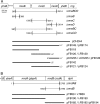
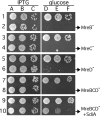
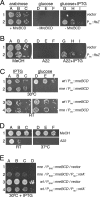
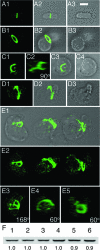




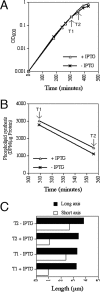

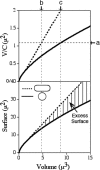
Similar articles
-
The morphogenetic MreBCD proteins of Escherichia coli form an essential membrane-bound complex.Mol Microbiol. 2005 Jan;55(1):78-89. doi: 10.1111/j.1365-2958.2004.04367.x. Mol Microbiol. 2005. PMID: 15612918
-
Chlamydial MreB Directs Cell Division and Peptidoglycan Synthesis in Escherichia coli in the Absence of FtsZ Activity.mBio. 2020 Feb 18;11(1):e03222-19. doi: 10.1128/mBio.03222-19. mBio. 2020. PMID: 32071268 Free PMC article.
-
Mutations in cell elongation genes mreB, mrdA and mrdB suppress the shape defect of RodZ-deficient cells.Mol Microbiol. 2013 Mar;87(5):1029-44. doi: 10.1111/mmi.12148. Epub 2013 Jan 21. Mol Microbiol. 2013. PMID: 23301723 Free PMC article.
-
MinD and role of the deviant Walker A motif, dimerization and membrane binding in oscillation.Mol Microbiol. 2003 Apr;48(2):295-303. doi: 10.1046/j.1365-2958.2003.03427.x. Mol Microbiol. 2003. PMID: 12675792 Review.
-
Is the cellular and molecular machinery docile in the stationary phase of Escherichia coli?Biochem Soc Trans. 2015 Apr;43(2):168-71. doi: 10.1042/BST20140267. Biochem Soc Trans. 2015. PMID: 25849912 Review.
Cited by
-
DrpB (YedR) Is a Nonessential Cell Division Protein in Escherichia coli.J Bacteriol. 2020 Nov 4;202(23):e00284-20. doi: 10.1128/JB.00284-20. Print 2020 Nov 4. J Bacteriol. 2020. PMID: 32900831 Free PMC article.
-
Recruitment of the TolA Protein to Cell Constriction Sites in Escherichia coli via Three Separate Mechanisms, and a Critical Role for FtsWI Activity in Recruitment of both TolA and TolQ.J Bacteriol. 2022 Jan 18;204(1):e0046421. doi: 10.1128/JB.00464-21. Epub 2021 Nov 8. J Bacteriol. 2022. PMID: 34748387 Free PMC article.
-
Peptidoglycan: Structure, Synthesis, and Regulation.EcoSal Plus. 2021 Jan;9(2):eESP-0010-2020. doi: 10.1128/ecosalplus.ESP-0010-2020. EcoSal Plus. 2021. PMID: 33470191 Free PMC article.
-
Recent advances in pneumococcal peptidoglycan biosynthesis suggest new vaccine and antimicrobial targets.Curr Opin Microbiol. 2012 Apr;15(2):194-203. doi: 10.1016/j.mib.2011.12.013. Epub 2012 Jan 24. Curr Opin Microbiol. 2012. PMID: 22280885 Free PMC article. Review.
-
Intracellular ion concentrations and cation-dependent remodelling of bacterial MreB assemblies.Sci Rep. 2020 Jul 20;10(1):12002. doi: 10.1038/s41598-020-68960-w. Sci Rep. 2020. PMID: 32686735 Free PMC article.
References
-
- Barbour, A. G., L. W. Mayer, and B. G. Spratt. 1981. Mecillinam resistance in Escherichia coli: dissociation of growth inhibition and morphologic change. J. Infect. Dis. 143114-121. - PubMed
Publication types
MeSH terms
Substances
Grants and funding
LinkOut - more resources
Full Text Sources
Molecular Biology Databases

